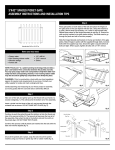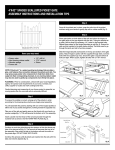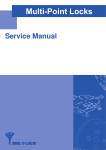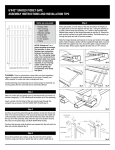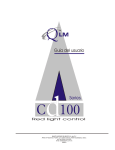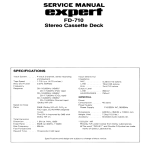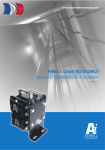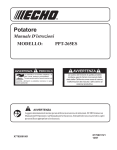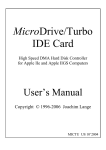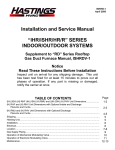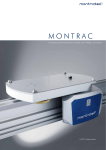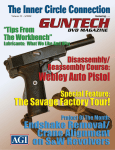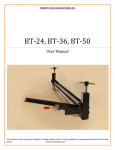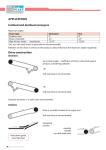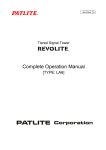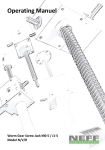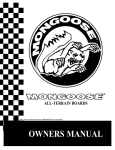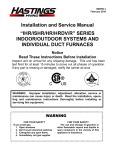Download Inner Drive Manual - Conveyor Configurator
Transcript
Driven By Customers … Powered by Proven Products Table of Contents Section I – General Warnings – General Safety Foreword Product Description Tools Required 1.01 1.02 1.03 1.04 Section II – Setup and Installation When Your Shipment Arrives Sequence of Installation Conveyor Orientation Aluminum Exact Width Stands Angle Braces Aluminum Cross Ties Casters Steel Telescoping Stands Steel Cross Ties Steel Stands with Stabilizers Universal Side Mounts Bottom Mounts Rod Clamp Mounts Fixed Side Rails Adjustable Guides Indented Guides 2.01 2.02 2.03 2.04 2.05 2.06 2.07 2.08 2.09 2.10 2.11 2.12 2.13 2.14 2.15 2.16 Section III – Maintenance Maintenance Foreword Belt Tracking Replacing the Motor Pulley Belt Change Adding Tension Belt Care Bearing Replacement Conveyor Exploded View and Parts List Recommended Spare Parts Troubleshooting 3.01 3.02 3.03 3.04 3.05 3.06 3.07 3.08 3.09 3.10 Section IV – Warranty and Return Policy Conveyor Serial Number Conveyor Warranty, Lost or Damaged Goods Returns, Order Cancellation/Revision Policy 4.01 4.02 4.03 Installation, Maintenance, and Parts Manual InnerDrive Conveyors QC Industries LLC 4057 Clough Woods Dr. Batavia, OH 45103 (513) 753-6000 Fax: (513) 753-6001 www.qcindustries.com 1.01 Warnings – General Safety Observe safe practices when setting up and operating your QC Industries conveyor. Climbing, sitting, walking, or riding on conveyor can cause severe injury. Keep off conveyors. Do not operate conveyors in an explosive environment. Exposed moving parts can cause severe injury. Lock out power before removing guards. QC Industries cannot control the installation and/or application of conveyors. Taking protective measures is the responsibility of the user. When conveyors are used in conjunction with other equipment, or as part of a multiple conveyor system, check for potential pinch points and/or other mechanical hazards before system start-up. During normal operation, please make sure that all guards are in place and securely attached to conveyor. Loosening stand height or angle adjustment screws can cause conveyor sections to drop down unexpectedly, causing severe injury. Support conveyor sections prior to loosening stand height or angle adjustment screws. Injury is possible if the stands are not lagged to the floor, cross ties are not used, or angle braces are not present. Never place a conveyor in operation until all proper mounts are installed and secured. It is the end user’s responsibility to ensure that the support system is safe and secure. Never operate equipment unless all operating instructions are understood and all guards, interlocks, covers, safety devices or circuits and protective components are functioning properly. Never operate or service this equipment if under the influence of alcohol, drugs or other substances or conditions which decrease alertness or judgment. QC Industries InnerDrive Installation, Maintenance, and Parts Manual 1.02 Foreword Congratulations on purchasing a conveyor from QC Industries, LLC, the leader in low profile conveyors! QC Industries offers the finest low profile conveyors available, using the highest quality materials and state of the art manufacturing processes. QC Industries conveyors boast a number of innovative engineering features to assure you hassle-free setup, smooth operation, and years of continued low-maintenance use. We are proud of our quality products and are committed to providing you dependable service! Check your shipment Before opening the shipment, visually inspect the outside of the crate/box for shipping damage. Carefully unpack the crate/box, inspecting for component damage which may have occurred inside the packing materials. Contact the carrier and QC Industries regarding any damage that may have occurred during shipment. Check the contents of your shipment against the supplied packing slip and inform QC Industries of any discrepancies. Please read this manual Inside this manual you will find instructions on how to set up and maintain your QC Industries conveyor properly, as well as maximize its performance. Please take the time to read this manual and familiarize yourself with these setup and maintenance instructions. These instructions will help assure a long product life that requires a minimum amount of service, and keeps your conveyor working at its maximum capacity. If you need assistance If you need assistance with your QC Industries conveyor, our highly trained support staff is only a phone call away. QC Industries welcomes the opportunity to assist you. You can contact the Customer Service department Monday through Friday, 8am-5pm EST at (513) 753-6000. In addition, your local distributor can provide support in many ways. Our distributors have been trained at the factory and can be dispatched to your facility to help. You can also visit our website for additional information and technical documents: www.qcindustries.com QC Industries InnerDrive Installation, Maintenance, and Parts Manual 1.03 Product Description The InnerDrive Conveyor has many typical conveyor components. Below is a description of the basic parts and options for the InnerDrive Conveyor (Figure 1). 6 2 5 3 1 4 10 7 8 9 Figure 1 Typical Components 1. 2. 3. 4. 5. 6. Conveyor Sides & Guide Accessories Standard Mounts Support Stands Idler End Motor Pulley End QC Industries InnerDrive Installation, Maintenance, and Parts Manual 7. 8. 9. 10. Angle Brace Cross Ties Leveling Foot Control Box 1.04 Tools Required Set of Standard Allen Wrenches: 3/32”, 7/64”, 1/8”, 3/16”, 5/32”, 1/4” Large Adjustable Wrench A Bubble Level for frame alignment Set of Metric Allen Wrenches: 2.5mm, 3mm Wide Flat Head Screw Driver OR Tail Turning Tool* in Socket Wrench QC Industries Part Number TK-TAILTURN Screw Gun with T25 Torx bit Aluminum and Steel Cutting Hack Saw or equivalent Wrenches: 1/4”, 7/16”, 9/16”, 3/4” Tape Measure * The Tail Turning Tool is QC Industries part number TK-TAILTURN. Please contact QC Industries Customer Service at (513) 753-6000 to purchase. QC Industries InnerDrive Installation, Maintenance, and Parts Manual 2.01 When Your Shipment Arrives n Check your shipment for damage a. If you have not already done so, visually inspect the outside of the crate or boxes for shipping damage. b. Carefully unpack the crate or box, inspecting the components for damage which may have occurred inside the packing materials. c. Contact the carrier and QC Industries regarding any damage that may have occurred during shipment. d. Check the contents of the shipment against the included packing slip and notify QC Industries of any discrepancies. o Locate the items from your order a. Each conveyor will ship in its own custom built box. b. Steel Telescoping Stands and Aluminum Multiple Conveyor Stands will ship in individual boxes. Aluminum Exact Width Stands ship two to a box. c. Casters are included in a separate box from the conveyor. d. Cross Ties will ship in a custom built box; the mounting hardware will ship in a bag in a separate box from the conveyor. e. Mounts are packaged in a separate box from the conveyor. f. Sides and Guiderails will ship in the conveyor’s box, with the exception of 24” wide conveyors whose boxes are too wide to also accommodate sides; in this case the Siderails or Guiderails will ship in a custom built box. Clamps to hold the siderail to the conveyor will be attached to the conveyor at the factory; mounting brackets for guides and hardware will ship in a separate plastic bag in a box separate from the conveyor. p Record the Conveyor’s Serial Number a. The conveyor’s serial number is located on the frame at the drive end of the conveyor, opposite the side on which the motor lead wire and control card will be mounted. b. Record the serial number in a place where it can be accessed for reference; a place has been provided on the back cover that can be used for multiple conveyors. This will assist any future inquires regarding the conveyor, its accessories, the order it was shipped on, or replacement parts. c. Proceed to Section 2.02 for the Sequence of Installation. QC Industries InnerDrive Installation, Maintenance, and Parts Manual 2.02 Conveyor Orientation To set up the conveyor after receiving your shipment, QC Industries recommends following these steps. Please refer to their respective sections for more detailed instructions. n Move the Conveyor and Accessories into location Using appropriate equipment and safe moving methods, move the conveyor and accessories to the desired assembly, staging, or installation area (Figure 1). Set the conveyor in the correct operating orientation with regard to the drive position and belt direction. See Section 2.03 for detailed instructions Figure 1 o Mount the Conveyor to its Stands and Cross Ties or Mounts Use QC Industries stands and mounts (or any compatible stands and hardware) to mount the conveyor in the desired location (Figure 2). Make sure the conveyor mounted on stands is on a flat, level surface. QC Industries recommends that stands with leveling feet are anchored to the floor. See Sections 2.04 – 2.13 for detailed instructions Figure 2 p Install the Sides or Guides It is recommended that Side and Guide Rail Assemblies are next in the sequence (Figure 3). See Sections 2.14 – 2.16 for detailed instructions Figure 3 QC Industries InnerDrive Installation, Maintenance, and Parts Manual 2.03 Conveyors 12’ Long and Under n Orient the Conveyor based on the Drive Location a. Set the conveyor in its operating position, taking care to note where the drive will be located. InnerDrive Conveyors can be built with the drive pulling; with a left hand drive or right hand drive (left hand and right hand are defined as if you are standing at the drive end of the conveyor). The 14th digit in the conveyor’s part number will indicate the orientation and direction, as shown in the following example of a 12” wide x 10’ long conveyor: 1MSCH12-120-AABA-MAA There are two positions available (Figure 1): A Left Hand, Drive Pulling B Right Hand, Drive Pulling A A B B Figure 1 b. Position the conveyor for operation, taking care to note that access is needed for the tail idler’s 1/4-28 Button Head Socket Screw (Figure 2) when other equipment is nearby. This is important when tensioning the belt from the tail end. 1/4 - 28 Button Head Socket Screw o Install Stands, Mounts, Sides, and Guides Figure 2 a. Proceed to Sections 2.04 – 2.13 for instructions on installing Stands and Mounts. b. Proceed to Sections 2.14 – 2.16 for instructions on installing Sides or Guides. QC Industries InnerDrive Installation, Maintenance, and Parts Manual 2.04 Aluminum Exact Width Stands Aluminum Exact Width Stands can be located anywhere along the length of the frame, as they mount directly to the conveyor’s accessory holes in the frame. Ideally, the stands should be placed as far apart as possible for maximum stability. The stand at the Tail End of the conveyor normally has no obstructions and can be placed as close to the end as needed. n Prepare the Stand for Installation a. For shipment, the stands will have their mounting bracket slid down the extrusion. Use a 1/2” Wrench to loosen the Hex Head Screws holding the Brackets and move them up to engage the conveyor frame, approximately 1 1/2” (or more for cleated belts) (Figure 1). b. If the stands are to be used with Aluminum Cross Ties, it is advised to attach the Gusset Plates prior to mounting the conveyor (Figure 2). Refer to Section 2.06 on Aluminum Cross Ties for specific instructions. Operating Position Shipping Position Figure 1 Cross Tie Gusset Plate Figure 2 o Install the Stand a. Locate the bag of 10-32 x 7/8” long Torx Head Thread Forming Screws from one of the boxes with the shipment. There are four per stand. b. Line up the stand with the accessory holes in the side of the conveyor frame and use a Screw Gun with a Torx bit to fasten the stand to the frame (Figure 3). Figure 3 QC Industries InnerDrive Installation, Maintenance, and Parts Manual 2.04 Aluminum Exact Width Stands (continued) p Adjust the Height using the Leveling Feet Hex Nut The Leveling Feet on all of QC Industries Stands are designed to allow fine adjustment and so they can be lagged to the floor. Note: if it is not feasible to permanently attach the stands to the floor or the conveyor is to be made mobile with casters, then Cross Ties or Angle Braces must be used. To adjust the stand height with the Leveling Feet: a. Use a large adjustable wrench to loosen the Hex Nut Lag to floor here Welded Hex Figure 4 b. Rotate the hex welded to the foot to the desired height (Figure 4). c. Retighten the Hex Nut to secure it in position. Injury is possible if the stands are not lagged to the floor, cross ties are not used, or angle braces are not present. Never place a conveyor in operation until all proper mounts are installed and secured. d. Frame alignment is one of the key items that assure the belt properly tracks during startup. Make sure the conveyor frame has no twist by using a bubble level and checking measurements from the mounting surface. e. Proceed to Section 2.05 for instructions on installing Angle Braces. f. Proceed to Section 2.06 for instructions on installing Aluminum Cross Ties. g. Proceed to Sections 2.14 – 2.16 for instructions on installing Sides and Guides. QC Industries InnerDrive Installation, Maintenance, and Parts Manual 2.05 Angle Braces When it is not feasible to bolt the Aluminum Exact Width Stands to the floor, they can be stabilized by use of Angle Braces. Angle Braces will only work for conveyors mounted horizontally. If your conveyor is mounted at an incline, Cross Ties must be used instead. Also, Angle Braces will only work with stands that are 18” or taller (i.e. part number 0182-18-21-WW). Angle Braces are shipped as a set, with one Right Hand Brace and one Left Hand Brace, with four Torx Head Screws, and four screw sets (Hex Head Screw, Flat Washer, and Square Nut). Square Nut Before installing Angle Braces, the Aluminum Exact Width Stands should already be assembled to the conveyor. n Install the Angle Braces to Exact Width Stands a. Start by inserting the square nuts in the stand leg’s channel at the base where the channel has been routered (Figure 1). Figure 1 b. Place the Angle Brace over the Square Nuts, and insert the Hex Screws and Washers into Square Nuts (but do not fully tighten them). There are four holes provided, but only two of them will be used. c. Using a Screw Gun with a Torx bit, drive the Torx Head Screws into the top section of the Brace (Figure 2). The holes will line up with accessory holes in the conveyor’s frame. d. Tighten the Hex Head Screws so the Brace is secured to the stand, and repeat the installation for the Brace on the other side. Torx Head Screw e. Frame alignment is one of the key items that assure the belt properly tracks during startup. Make sure the conveyor frame has no twist by using a bubble level and checking measurements from the mounting surface. f. Proceed to Sections 2.14 – 2.16 for instructions on installing Sides and Guides. Figure 2 QC Industries InnerDrive Installation, Maintenance, and Parts Manual 2.06 Aluminum Cross Ties When it is not feasible to bolt the Aluminum Stands to the floor, the conveyor and stand assembly can be stabilized by use of Cross Ties. Cross Ties are sold in standard lengths, and are meant to be cut to length during installation based on the final placement of the stands. The Cross Ties can be installed once the conveyor has been secured to the stands. In one of the boxes of the shipment, there will be a bag containing the Cross Tie Gusset Plates and fasteners. n Install the Gusset Plates to Aluminum Stands a. Insert two Square Nuts into each leg’s channel from the base where the channel has been routered (Figure 1). b. The Gusset Plate should be positioned over the Square Nuts in the channel and secured with the Hex Head Screws and Flat Washers (Figure 2). Although there are eight holes in the Gusset Plate, only four of them will be used. Figure 1 Figure 2 o Install the Cross Tie Extrusions a. Measure the distance between the stands and cut the Cross Tie Extrusion to fit with a saw blade that is appropriate for Aluminum (Figure 3). b. The Gusset Plates can mount to the inside or outside of the stand’s leg, or to the stand’s Cross Member if there is no room on the leg (note: this will require disassembly of the stand to do so). CutCross Cross Tie Tie to Cut tolength length Figure 3 c. Proceed to Sections 2.14 – 2.16 for instructions on installing Sides and Guides. QC Industries InnerDrive Installation, Maintenance, and Parts Manual 2.07 Casters QC Industries offers swivel locking casters to replace the stands’ leveling feet for applications when conveyors need to be moveable. Casters will ship in a separate box from the stands. n Install Casters to Aluminum or Steel Stands a. Remove the Leveling Foot from the stand by loosening the Hex Nut with a large adjustable wrench. Spin the foot to unthread it from the stand leg until it is free. b. Install the Casters by threading the 4 1/2” stem into the base of the stand where the Leveling Foot was previously. The Caster will have its own 3/4-10 Hex Nut (Figure 1). c. Once the conveyor is mounted on the stand, the caster’s stem can be used for final height adjustment, up to 1 1/2” up or down. Use a large adjustable wrench to loosen the hex nut, engage the swivel lock, then rotate the caster to the desired height by hand, and finally retighten the Hex Nut to secure it in position. o Secure the System a. When the conveyor is not being moved or is in operation, the Caster’s swivel lock should be engaged. It is conveniently located over the caster’s wheel so it can be engaged and disengaged by foot. b. QC Industries requires the use of Cross Ties or Angle Braces if Casters are used. Note: The width of the system should be no less Figure 1 than 1/3 of the system’s height (i.e. for a 36” high system, a stand assembly on casters should be at least 12” wide). When assembling, please make sure the assembly is stable for your application. Warning: Moving conveyors with casters can create dynamic forces that could tip the conveyor. Use caution when moving a conveyor with casters. c. Proceed to Sections 2.14 – 2.16 for instructions on installing Sides and Guides. QC Industries InnerDrive Installation, Maintenance, and Parts Manual 2.08 Steel Telescoping Stands Steel Telescoping Stands are used when a wide range of adjustment is needed for the stands. They are available in four widths and four height ranges. The nominal stand width used must be at least 2” wider than the conveyor that will be mounted on it. n Adjust the Height of the Stand a. Adjust the Stand’s height to the desired elevation before mounting the conveyor. Loosen the Hex Head Screws that secure the channel with a 9/16” Wrench (Figure 1). If Cross Ties are to be used with the stands, it is recommended to install the Cross Tie Gusset Plates before finishing the height adjustment. See Section 2.09 for detailed instructions. b. Slide the stand’s H Section up or down in the channel. Re-tighten the screws to secure it in position. Loosen to adjust height If it is necessary to use the stand’s telescoping adjustment once the conveyor it installed, the conveyor must be supported by some other means, as the stand will not support any weight during the adjustment. o Determine the Stand Locations Figure 1 a. The stand at the drive end and idler end of the conveyor normally have no obstructions and can be placed as close to the ends as needed. Ideally, the stands should be placed as far apart as possible for maximum stability. p Install the Mount a. Use of Steel Telescoping Stands requires the use of a separate mount, which is not included with the stand. b. Instructions for installing mounts to the conveyor and stand are in Sections 2.11 – 2.13. QC Industries InnerDrive Installation, Maintenance, and Parts Manual 2.08 Steel Telescoping Stands (continued) q Adjust the Leveling Foot a. Once the conveyor is mounted on the stand, the Leveling Feet can be used for final height adjustment, up to 1 1/2” up or down. b. Use a large adjustable wrench to loosen the Hex Nut, then rotate the hex welded to the foot to the desired height (Figure 2), and finally retighten the 3/4-10 Hex Nut to secure it in position. c. The Leveling Feet on all of QC Industries Stands are designed so they can be lagged to the floor. If it is not feasible to permanently attach the stands to the floor or the conveyor is to be made mobile with casters, then Cross Ties must be used. Figure 2 Injury is possible if the stands are not lagged to the floor, cross ties are not used. Never place a conveyor in operation until all proper mounts are installed and secured. d. Frame alignment is one of the key items that assure the belt properly tracks during startup. Make sure the conveyor frame has no twist by using a bubble level and checking measurements from the mounting surface. e. Proceed to Sections 2.14 – 2.16 for instructions on installing Sides and Guides. QC Industries InnerDrive Installation, Maintenance, and Parts Manual 2.09 Steel Cross Ties When it is not feasible to bolt Steel Stands to the floor, the conveyor and stand assembly can be stabilized by use of Cross Ties. Cut to length length CutCross Cross Tie to Cross Ties are sold in standard lengths, and are meant to be cut to length during installation based on the final placement of the stands. n Cut the Unistrut to length Figure 1 Measure the inside distance between the stands and cut the unistrut sections to length with a saw blade that is appropriate for steel (Figure 1). o Install the Gusset Plates to the Steel Stand The Gusset Plates mount through the holes in the lower leg of the stand assembly (Figure 2). a. To install, the H Section of the stand must first be lifted clear of the mounting holes (Figure 3). b. Place a Gusset Plate over the holes in the Stand Leg’s Base, and insert a 3/816 x 1 1/2” Hex Head Screw with a 3/8” Flat Washer through the two holes. Gusset Plate Double Nut Clamp c. Secure the Gusset Plate by positioning a Double Nut Clamp in the inside of the Stand Leg, and threading the Hex Head Screws into it. Install in leg holes Figure 2 d. The Double Nut Clamp can be used to engage the Stand’s H Section if the Double Nut Clamp creates an interference with the H Section. p Install the Cross Tie to the Gusset Plate a. Position a Double Nut Clamp over the remaining 3/8” holes in the Gusset Plate, insert Hex Head Screws with Washers through, and engage them loosely into the Double Nut Clamp. b. Slide the Unistrut Cross Tie in behind the Nut Clamp so it butts up against the Stand Leg, and secure it in place by tightening the Hex Head Screws. Stand H Section Double Nut Clamp c. Proceed to Sections 2.14 – 2.16 for instructions on installing Sides and Guides. Figure 3 QC Industries InnerDrive Installation, Maintenance, and Parts Manual 2.10 Steel Stands with Stabilizers Steel Stands with Stabilizers are used when it is not possible to support the conveyor with more than one stand. 1” Screw They are available in four widths and four height ranges. The nominal stand width used must be at least 2” wider than the conveyor that will be mounted on it. Washer Unistrut n Install the Stabilizers to the Leveling Feet a. Rotate the feet so the holes 2” apart are in line (Figure 1). b. Slide the Double Nut Clamp into the unistrut channel. c. Assemble the feet to the channel with the 3/8-16 x 1” Hex Head Screws and 3/8” Washers from the top of the foot, into the Double Nut Clamp and tighten them into position. The fine adjustment using the leveling feet is not available once the stabilizers are installed. Leveling Foot Double Nut Clamp Figure 1 o Adjust the Height of the Stand a. Adjust the Stand’s height to the desired elevation before mounting the conveyor. Loosen the Hex Head Screws that secure the channel with a 9/16” Wrench (Figure 2). b. Slide the stand’s H section up or down in the channel. Re-tighten the screws to secure it in position. Loosen to adjust height If it is necessary to use the stand’s telescoping adjustment once the conveyor it installed, the conveyor must be supported by some other means, as the stand will not support any weight during the adjustment. p Determine the Stand Location a. The stand at the drive end and idler end of the conveyor normally have no obstructions and can be placed as close to the ends as needed. Ideally, the stands should be placed as far apart as possible for maximum stability. Figure 1 q Install the Mount a. Steel Stands require the use of a separate mount. Instructions for installing mounts to the conveyor and stand are in Sections 2.11 – 2.13. b. Proceed to Sections 2.14 – 2.16 for instructions on installing Sides and Guides. QC Industries InnerDrive Installation, Maintenance, and Parts Manual 2.11 Universal Adjustable Side Mounts The Universal Adjustable Side Mounts are used to support the conveyor above its mounting surface. There are three versions available: Frame Mounted (125-0181-04), Tee Slot Mounted (125-0181-01), Multi-Tier Stand Mount (125-0181-05). They are each supplied with fasteners appropriate for the style of mounting. If the conveyor has a cleat height of 1”, 2”, or 3” the Universal Raised Side mount is used. It will create a higher top of belt height from the mounting surface or stand top plate. The Universal Raised Side Mount is available in three versions as well: Frame Mounted (125-0182-04), Tee Slot Mounted (1250182-01), and Multi-Tier Stand Mounted (125-0182-05). n Frame Mounted Universal Adjustable Side Mounts a. For the frame mounted versions, the mount can be installed on the conveyor anywhere along its length that there are accessory holes available (Figure 1). Mount to Accessory Holes in Frame b. The thread-forming 10-32 x 7/8” Torx Head Screws provided with the Mounts are long enough to allow accessories to be stacked over one another (such as a Guide Bracket). Torx Screws Figure 1 o Tee Slot Mounted Universal Adjustable Side Mounts Washer Hex Nut a. For the Tee Slot Mounted version (Figure 2), insert the 1/4-20 Square Nuts in the tee slot, and thread the 1/4-20 x 1” Set Screws into the Square Nuts. b. Locate the Mount over the Set Screws, and tighten them in place so they dig into the tee slot. Mount to Tee Slot c. Secure the Mount by placing 1/4” Flat Washers onto the Set Screws and threading 1/4-20 Hex Nuts onto them. Figure 2 QC Industries InnerDrive Installation, Maintenance, and Parts Manual 2.11 Universal Adjustable Side Mounts (continued) p Install the Mount to a Steel Stand Screw The Frame Mounted and Tee Slot Mounted versions of the Side Mount can be secured to the top plate of a Steel Telescoping Stand. Washer a. Using the fasteners provided, insert a 5/16-18 x 3/4” Hex Head Screw through a 5/16” Flat Washer and into the slot in the base of the mount (Figure 3). b. Secure the mount using a second Flat Washer and 5/16-18 Hex Nut from the underside of the stand. Mount to Steel Stand Washer Hex Nut Figure 3 p Multi-Tier Stand Mounted Universal Adjustable Side Mounts Square Nut Channel Routered The Multi-Tier Stand version mounts to the conveyor the same as the frame mounted version, but comes with Square Nuts and Hex Head Screws for mounting into the channels of the top extrusion of the Aluminum Multi Tier Stand, through the two holes in the mount’s base. a. To install, insert one 5/16-18 Square Nut into each channel of the Stand’s Top Extrusion (Figure 4). The channel has been routered to accommodate the Square Nut. Figure 4 b. Place the Mount over the Square Nuts, and thread a 5/16-18 x 3/4” Hex Head Screw with 5/16” Flat Washer through the mount and into the Square Nut (Figure 5). Leave the assembly slightly loose for adjustment in the next step. Washer Hex Screw Washer c. Secure the Mount to the conveyor using a Screw Gun with a Torx bit and the 10-32 x 7/8” Thread Forming Torx Head Screws with #10 Flat Washers. Thread Forming Screw d. Tighten the Mount to the Stand. e. Proceed to Sections 2.14 – 2.16 for instructions on installing Sides and Guides. Figure 5 QC Industries InnerDrive Installation, Maintenance, and Parts Manual 2.12 Bottom Mounts The Bottom Mount is designed to secure itself to the underside flanges of the conveyor frame. Because the top part of the mount can interfere with the belt’s return path, it cannot be used with high friction or cleated belts. If stands were not ordered with the Bottom Mount, it can be mounted to a flat surface, or face-mounted to a vertical surface. n Installing Bottom Mounts on Steel Telescoping Stands a. Back out the set screws in the mount’s base. b. Slide the mount into the conveyor’s flange and tighten the set screw to the frame (Figure 1). The Mount can be located anywhere along the length of the conveyor frame. c. Secure the Bottom Mount to the top plate of the Steel Stand or mounting surface using the 1/4-20 Socket Head Cap Screws, Washers, and Hex Nuts provided (Figure 2). Set Screw Set Screw Figure 1 d. If the Stand is only 2” wider than the conveyor, then the slots off of the center of the Stand’s Top Plate will have to be used for mounting (Figure 3). Slots off center Figure 2 Center slots o Face-Mounting Bottom Mounts Figure 3 a. Back out the set screws in the mount’s base. b. Slide the mount into the conveyor’s flange and tighten the set screw to the frame (Figure 1). The Mount can be located anywhere along the length of the conveyor frame. c. Insert 5/16” diameter screws (not included) into the holes in the Bottom Mount’s face, and into the surface to which it will be mounted (Figure 4). Holes Holesforfor 5/16” Screw 5/16" Screw d. Proceed to Sections 2.14 – 2.16 for instructions on installing Sides and Guides. Figure 4 QC Industries InnerDrive Installation, Maintenance, and Parts Manual 2.13 Rod Clamp Mounts Rod Clamp Mounts are used to rigidly hold a conveyor to a mounting surface. They can only be positioned in the Rod Clamp Holes provided as a standard feature in the frame at the idler end and drive end. Rod Clamp Mounts are manufactured to be installed to Steel Telescoping Stands or to a flat surface with tapped holes. The stand mounting uses 3/8-16 screws into a threaded hole in the Rod Clamp Mount; the Mount’s hole has also been counterbored for a 5/16-18 Socket Head Screw. n Rod Clamp Mounts on Steel Telescoping Stands a. To install, insert the Rod through the Rod Clamp Hole in the conveyor frame. Clamp RodRod Clamp Mount Mount b. Thread the screw from below the Steel Stand Top Plate or other mounting surface through the washer and into the tapped hole in the rod (Figure 1). c. If the Stand is only 2” wider than the conveyor, then the slots off of the center of the Stand’s Top Plate will have to be used for mounting (Figure 2). Washers Washers Slots off center 3/8-16 3/8-16Screws Screws Figure 1 Center slots Figure 2 o Surface Mounting for Rod Clamp Mounts a. Rotate the Rod Clamp Mount so the counterbore faces away from the mounting surface. b. Insert a 5/16-18 Socket Head Screw (not included) though the counterbore and into the mounting surface. To protrude past the bottom of the conveyor frame, the screw must be longer than 1”. 5/16 Socket Head Screw c. Proceed to Sections 2.14 – 2.16 for instructions on installing Sides and Guides. Figure 3 QC Industries InnerDrive Installation, Maintenance, and Parts Manual 2.14 Fixed Side Rails Fixed sides are available in 3 heights: 1/3”, 1”, and 2”. The 1” high and 2” high Siderails have a tee slot integrated into them that can be used to mount accessories. The tee slot is sized for a 1/4-20 Square Nut. Fixed sides are available in 3 styles: as a plain aluminum extrusion, with seals, or with UHMW wearstrip. Unlike Indented Guides and Adjustable Guides, Fixed Sides are not designed to be the full length of the conveyor. n Installing Fixed Sides In most cases, Fixed Sides should not be installed until the conveyor is mounted on its supports; the Universal Adjustable Side Mount with Tee Slot Mounting is the exception and requires that Fixed Sides are installed first. The conveyor will be shipped with Siderail Clamps loosely fastened to the side of the conveyor frame. In general, clamps will be spaced every 12” for 1/3” and 1” sides, every 9” for 2” sides. a. Loosen the 5/16” Socket Head Screw in the Tracking Block that is closest to the Driver Assembly (DO NOT loosen the second screw or the conveyor may need to be re-tracked) (Figure 1). Loosen this screwLossen this screw b. Slide the Siderail extrusion through the Siderail Clamps and into the Tracking Block’s groove, so the end of the rail is even with the end of the Tracking Block (Figure 2). Figure 1 c. Using a Screw Gun with a T25 Torx bit, tighten the Siderail Screws. d. Retighten the Socket Head Screw in the Tracking Block. o Sides with Seals If the sides have seals, the speed of the conveyor should be no faster than 30 feet per minute. The side seals are designed for use with the MAA Standard Urethane Belt. a. Some adjustment can be made to the pressure of the side seal on the belt by raising or lowering the rail within the siderail clamps. Seal Figure 2 QC Industries InnerDrive Installation, Maintenance, and Parts Manual 2.15 Adjustable Guides Adjustable Guides are available in 3 heights: 1”, 2”, and 3”, and are available with either thumbscrew adjustment or set screw adjustment. The Guiderails are supported by an assembly that must be built in place. n Mount the Guide Brackets a. Attach the Guide Brackets to the conveyor frame using the 10-32 x 7/8” Thread Forming Torx Head Screws provided (Figure 1). The large hole of the guide bracket should face upward. b. The Guide Brackets should be spaced on approximately 24” centers down the length of the conveyor. c. Secure a rod vertically to the Guide Bracket with a 1/4-20 x 1/2” Hex Head Screw and 1/4” Lock Washer from the underside of the Guide Bracket. Torx Screws Torx Screws Figure 1 o Prepare the Guide Rail a. Slide 1/4-20 x 1/4” Hex Head Screws into the tee slot of the Guiderail. If your guide assembly is the 1” version, these screws are already installed (Figure 2). b. Screw an Adjusting Rod over each screw and hand tighten, but leave it loose enough that the rod and screw can still slide in the tee slot. The rod’s locations should be approximately the same as the Guide Brackets mounted to the conveyor. c. Place a round Cross Block all the way down each adjusting rod so it touches the Guiderail and tighten it down with the Set Screw or Thumbscrew. Hex Head Screw Thumbscrew or Set Screw Cross Block Figure 2 QC Industries InnerDrive Installation, Maintenance, and Parts Manual 2.15 Adjustable Guides (continued) p Install the Guide Rail to the Brackets a. Install the Guiderail/Rod/Cross Block assembly over the vertical rods connected to the Guide Brackets, and secure them in place vertically (Figure 3). b. By loosening and tightening the fasteners in the Cross Block, the Guiderail can now be adjusted vertically or horizontally as needed; once in the desired location, finish tightening the horizontal rods so they hold the Guiderail rigidly. Figure 3 QC Industries InnerDrive Installation, Maintenance, and Parts Manual 2.16 Indented Guides Indented Guides are mainly used with cleated belts. They overhang the belt to create an enclosed pocket with the belt’s cleats, and are available in 3 heights: 1”, 2”, and 3”. The Guiderails are supported by a bracket assembly that must be built in place. n Mount the Guide Brackets a. Attach the Guide Brackets to the conveyor frame using the 10-32 x 7/8” Torx Head Screws provided (Figure 1). b. The guide brackets should be spaced on approximately 24” centers down the length of the conveyor. Figure 1 o Prepare the Guide Rail a. Slide the 1/4-20 Square Nuts into the tee slot of the guide rail. If your guide assembly is the 1” version, these nuts are already installed. b. Screw the 1/4-20 x 1” Set Screws into the 1/4-20 Square Nuts, positioning them so they are spaced evenly with the guide brackets. They do not need to be fully tightened at this time, as some adjustment in the channel may be necessary (Figure 2). Square Nut Hex or Jam Nut Set Screw c. For the 2” and 3” versions, lay a flat washer over the set screws. For the 1” version, screw Figure 2 the 1/4-20 Jam Nut over the 1” Set Screw (the Flat Washers/Jam Nuts act as a spacer to account for the difference in thickness of the 1” guiderail from the 2” and 3” rails). QC Industries InnerDrive Installation, Maintenance, and Parts Manual 2.16 Indented Guides (continued) p Mount the Guide Rail a. The Guiderail/Square Nut/Set Screw/Washer or Jam Nut assembly can now be set on the Guide Brackets attached to the conveyor (Figure 3). b. Once in place, a 1/4” Flat Washer and 1/4-20 Hex Nut are placed over the 1” Set Screw to secure its position to the Guide Bracket. Figure 3 QC Industries InnerDrive Installation, Maintenance, and Parts Manual 3.01 Maintenance Foreword Managing conveyor life is both a comprehensive and important consideration from the day a system is conceived until the day it is retired from service. From a business perspective, maintenance is an essential activity for the achievement of optimal return on investment, as well as a key to remaining competitive in a hyper-competitive world. Like maintenance for many other systems, the maintenance of conveyor systems divides into three broad categories: predictive, preventive, and corrective. The obvious advantage of predictive and preventive maintenance is that downtime surprises can be avoided, and when action needs to be taken, all of the parts, materials, and timing can be arranged for operational convenience. To assure the highest performance for your conveyor system, QC Industries has combined a selection of high quality durable components and superior design criteria that support all aspects of conveyor operational effectiveness with the minimal amount of conveyor preventive maintenance. Preventive maintenance, such as the cleaning of the conveyor, replacement of conveyor belt and bearings will be regimented by the type of environment the conveyor system is subjected to, the number of hours in operation, and the amount of performance demanded of the system. Predictive measures, such as belt replacement schedules, and overall equipment inspection shall be determined by the environment the conveyor is subjected to, the number of hours in operation, and the production effects of measures taken at the corrective phase. Maintenance, in general, affects all aspects of conveyor operational effectiveness and risks, not just system availability and cost — specifically safety, operational efficiency, energy efficiency, product quality, and environmental integrity. The following sections are QC Industries’ requirements for assuring the conveyor system is always operating at the factory specifications with minimal production interruption please follow these guidelines. If any questions arise please call our customer service department at (513) 753-6000. QC Industries InnerDrive Installation, Maintenance, and Parts Manual 3.02 Belt Tracking With the exception of 2-piece frame extended length conveyors, all InnerDrive conveyors are shipped assembled with the belt pre-tensioned and pre-tracked from the factory. You should not have to adjust the tracking of the belt; however, if there is a need to track the belt, stop the conveyor immediately and follow the instructions below. Belts can be tracked from both the Drive and Tail Ends of the conveyor, but it is recommended to start at the Drive End first. n Track the Drive End a. Loosen all four 5/16” Driver Assembly Screws (two on each side) one-half turn (Figure 1). Bearing Bearing Plate Plate b. With the conveyor running, rotate the 1/4" Square Head Tracking Screw toward the Motor Pulley on the side of the conveyor where the belt is riding too close – this will set the Driver Assembly at an angle and move the belt away from that side. For best results, make adjustments to only one side. The Drive End is tracked when the belt can make a full revolution without contacting either bearing plate. Loosen Socket Head Loosen Socket Screws before Head Screws adjusting before adjusting Rotate Tracking Rotate Tracking Screw to adjust Screw to adjust tracking tracking Figure 1 o Track at the Tail End A unique feature to QC Industries InnerDrive conveyor is the Eccentric Tail Pulley Assembly, which allows tracking of the belt and provides a single point for belt tension. The pulley is initially assembled to the conveyor in the “neutral” position (defined as the index mark in the 12 o’clock position), but may have been adjusted at the factory for belt tracking purposes; therefore, your tail assembly may not be in the neutral position when received. Neutral a. To track the Tail End, first loosen the 1/4-28 Button Head Socket Cap Screw which secures the Eccentric Bushing with a 5/16” Wrench (Figure 2). b. Using a 9/16” Wrench, rotate the Eccentric Bushing clockwise (toward the 3 o’clock position) to track belt toward the 1/4-28 Button Head Socket Cap Screw; rotate the Eccentric Bushing counterclockwise (toward the 9 o’clock position) to track the belt away from the 1/4-28 Button Head Socket Cap Screw. Loosen 1/4-28 Button Head Screw Allow the belt to make a full revolution to determine if more adjustment is necessary. On longer conveyors, wider conveyors, or conveyors running at slower speeds, tracking adjustments will take more time than on shorter and narrower conveyors. Let the belt make at least two revolutions before making additional adjustments. Figure 2 The Tail End is tracked when the belt can make a full revolution without contacting either side of the frame. When finished, tighten the 1/4-28 Button Head Socket Cap Screw to secure the Eccentric Bushing. QC Industries InnerDrive Installation, Maintenance, and Parts Manual 3.03 Replacing the Motor Pulley Make sure to turn off all power and other machines integrated with the conveyor before removing or replacing the Motor Pulley. n Release Belt Tension a. At the tail end rotate set screw clockwise until it clears the inside of the frame (Figure 1). B A b. Rotate the tail shaft counter-clockwise (using a Flat Head Screw Driver) until the tension from the belt is released (Figure 1). c. Then, remove the tail shaft by sliding it out from under the belt. Figure 1 o Remove the Drive Cover and Junction Circuit Board a. Remove both Drive Covers by using a 7/64” Allen Wrench and remove the 2 Socket Head Cap Screws and pull the covers off (Figure 2). b. Then, unhook both wires which are plugged into the Junction Circuit Board, being extremely careful not to pinch the wires. Pinching the wires could cause damage to the wire, possibly leading to malfunctions. c. Next, remove the Junction Circuit Board by removing both screws, using a 2.5mm Allen wrench. Then remove Junction Circuit Board (Figure 2). Figure 2 p Remove Drive Mount and Motor Pulley a. Using a 3/4” Wrench or an Adjustable Wrench, remove the 3/4” Nut and Serrated Lock Washer from each side of the Motor Pulley. Be careful when sliding the nut and washer down the cable and over the connection plug (Figure 3). b. On the side where the lead wires come out of the motor, remove the 2 Socket Head Cap Screws that hold the drive plate on using a 1/4” Allen Wrench (Figure 3). Figure 3 c. Slide the drive plate off making sure you support the end of the motor pulley. Again, be careful when sliding the plate down the wire and over the connection plug (Figure 3). d. Finally, pull the Motor Pulley out and replace, following the above steps in reverse order. Once conveyor is completely reassembled, allow the conveyor to run for several revolutions before applying load to ensure it is properly tracked. Refer to Section 3.02 to review instructions on Belt Tracking. QC Industries InnerDrive Installation, Maintenance, and Parts Manual 3.04 Belt Change QC Industries recommends stocking at least one replacement belt for every conveyor ordered. This will minimize downtime and ensure optimum performance for your particular application. n Remove the existing belt a. Locate the Set Screw in the Tail Assembly on the conveyor. Using a 3/32” Allen Wrench, rotate the Set Screw into the Tail Shaft until it clears the inside of the Frame (Figure 1). Figure 1 b. Remove tension from the belt by rotating the Tail Assembly 180 degrees with a Tail Turning Tool or a wide Flathead Screwdriver (Figure 2). Figure 2 c. Remove the Tail Assembly from inside the Frame (Figure 3). Figure 3 d. Remove the black Drive Cover by using a 7/64” Allen Wrench to remove the two Socket Head Screws holding it in place (Figure 4). NOTE: It is only necessary to remove the black Drive Cover opposite the Lead Wires coming out of the motor. Figure 4 QC Industries InnerDrive Installation, Maintenance, and Parts Manual 3.04 Belt Change (continued) e. Remove the Drive Mounting Plate by unscrewing the two Socket Head Screws using a 1/4” Allen Wrench (Figure 5). Figure 5 f. Pull off the Drive Mounting Plate with one hand and support the Drive Pulley with the other hand (Figure 6). Figure 6 g. Remove the belt by transferring the slack to the Drive End of the conveyor. To do this, slide the belt out of the flanges on both sides of the conveyor, located on the bottom side of the conveyor. Pull the belt off the conveyor from the drive end first (Figure 7), being careful not to go too fast to avoid damaging to the Drive Motor. For wider and longer conveyors, it may be necessary to have another person help to hold the conveyor and belt. Figure 7 QC Industries InnerDrive Installation, Maintenance, and Parts Manual 3.04 Belt Change (continued) o Install the new belt a. Starting at the Tail End, loop the belt over the end of the frame, inside the cutout for the idler. Then slide the belt over the Drive End (Figure 8). Figure 8 b. Snap the belt into the frame flanges up to the Drive End (Figure 9). Now replace the Drive Mounting Plate and Drive cover. Figure 9 c. Replace the Tail Assembly at the Idler End, by inserting it from the side of the conveyor, under the belt and over the slider bed with the slotted side next to the notch in the frame cutout (Figure 10). Figure 10 d. Set the initial tension by rolling the Tail Pulley off of the end of the conveyor, so that it ‘pops’ into the tail cutout. For wide conveyors, it may require significant leverage to do so, possibly requiring one person to steady the conveyor while the other installs the pulley (Figure 11). Figure 11 e. Once the Tail Pulley is in position, using a Tail Turning Tool or a wide Flathead Screwdriver, rotate the Tail Pulley clockwise until the Set Screw is in position. Then, rotate the Set Screw counterclockwise until flush with the outside of the frame (Figure 12). The conveyor is now ready to be tracked as instructed in Section 3.02. Figure 12 QC Industries InnerDrive Installation, Maintenance, and Parts Manual 3.05 Adding Tension All InnerDrive conveyors are shipped assembled with the belt pre-tensioned and pre-tracked from the factory. This process ensures that the belt has the recommended amount of tension to maximize the conveyors load carrying capacity. For the life of a standard belt, you should not have to adjust the tension of the belt; however, if there is a need to add additional tension to extend the service life of a belt that has elongated, the Tracking Screws may be used to increase tension. Note: overtensioning belts adds unnecessary load to bearings, and subsequently will reduce the bearings useful life. n Add tension to the Belt a. Loosen all four 5/16” Driver Assembly screws (there are two on each side of the conveyor) one-half turn (Figure 1). b. Increase the tension by extending the 1/4" Square Head Tracking Screws until desired tension is achieved. On the drive side of the conveyor the tracking screw will push against the Drive Mounting Plate. On the opposite side there is an Anvil Tracking Block which the Tracking Screw pushes against. The screws should be extended the same amount so the belt tracking is not affected (refer to Belt Tracking in Section 3.02). c. If after following these steps additional belt tension is needed, it is recommended that a new belt be purchased. Rotate Rotate Tracking Tracking Screws to Screws to add tension add tension Loosen Loosenbefore before adjusting adjusting Figure 1 QC Industries InnerDrive Installation, Maintenance, and Parts Manual 3.06 Belt Care n Belt Cleaning Belts can usually be cleaned with general household cleaners, however some cleaners (that contain alcohols, acetone, MEK, chlorinated solvents, etc.) may attack belts. o Physical Damage Worn edges do not hurt the conveyor's operation, as the pulleys are crowned; however, the cause of the edge wear should be determined. Scoring lines in the belt's surface could be due to product collecting between the frame's underside flange and the belt. If the conveyor has a wiper, product could be trapped at the scraping edge. Accessories, such as adjustable guides or bottom mounts could be improperly positioned and in contact with the belt. p Camber Belt camber is the lateral oscillation of the belt, most noticeable at the drive end between the Bearing Plates. All belts have some camber due to the endless splice not being perfectly square. Crowned pulley and tracking adjustments should overcome the belt's camber, but in some cases will not (such as if the belt is excessively worn or has been exposed to an inappropriate chemical or solvent). Excessive camber is when the belt cannot be tracked without the edges staying in contact with the Bearing Plates. It is possible that the conveyor can continue to perform at a high level even with excessive camber, but if it is a problem, replacement of the belt is suggested. q Belt Slippage Belt slippage occurs when the belt is undertensioned for the load, which could be caused by a number of factors: a. Excessive load on the conveyor. Refer to the Product Catalog to determine the conveyor's application capacity. b. Reduced friction between the belt and Motor pulley. c. Belt elongation due to overtensioning. d. Excessive belt wear due to accumulating product. e. Belt elongation due to exposure to a chemical or ultraviolet light. If slippage cannot be overcome by either removing the condition causing it or by adding tension at the Drive End, it is likely the belt needs to be replaced. QC Industries InnerDrive Installation, Maintenance, and Parts Manual 3.07 Bearing Replacement InnerDrive conveyors use tail roller bearings which have been lubricated with Micro-Poly solid lubricant at the factory. QC Industries recommends that these bearings be removed and replaced as needed (See Table Below). n Bearing Replacement The replacement interval is dependent on the speed at which the conveyor is running and the environment it is in. The chart below shows the replacement interval in years. Replacement Interval in Years 1 Shift 2 Shifts 3 Shifts 6 3 2 Example: a conveyor running in a 3 shift operation can go 2 years between replacements. Note: The replacement interval can be drastically affected by environmental issues such as moisture, dust, heat, and chemicals. Please consider these when determining the correct interval for your application. The conveyor is shipped with a H1 Food-Grade Micro-Poly Lubricant which is a mixture of polymers, oils, and other additives. QC Industries InnerDrive Installation, Maintenance, and Parts Manual InnerDrive "A or B" Mechanical Assembly 15 1MSCHWW-LLL-XXXH-MAA 14 16 7 17 13 18 12 19 5 # 5 # # # 11 Item 1 2 3 4 5 6 7 8 9 10 11 12 Part No. 125-0027-00 125-0025-00-U 125-0072-025 125-0154-TB-LH 125-0074-004 125-0090-MPC-LH 125-0154-TB-RH ID-PCB-9-PIN 125-0080-020 125-ID-0012-LH 125-0073-061 ID-0144-WW-LLL Description PLATE DRIVER LOCK BRACKET DRIVER MOUNTING UNIVERSAL SCREW SQUARE HEAD SET 1/4-20 X 1/2" ZP BLOCK TRACKING LH 125 SERIES SCREW SOCKET HEAD SET 5/16-18 X 1" ZP MOUNT MOTORIZED PULLEY LH BLOCK TRACKING RH 125 SERIES BOARD JUNCTION CIRCUIT SCREW SOCKET HEAD CAP M3 X 6 ZP COVER INNERDRIVE LH DRIVE SCREW SOCKET HEAD CAP 6-32 X 1 1/8 SS FRAME INNERDRIVE "C" 10 Item 9 8 20 21 Part No. 6 4 3 2 1 Description 13 14 15 16 17 18 19 20 21 125-0078-024 125-0110-WW-E 1E-WW-LLL-MAA 125-0139-WW ID-COVER-PLUG 125-ID-0012-RH 125-0090-MPC-RH ID-PM-LN ID-PM-LW PLUG FRAME ASSY 125 ECCENTRIC TAIL BELT INNERDRIVE STANDARD URETHANE SPACER BLOCK 125 SERIES W/O STUDS PLUG COVER INNERDRIVE DRIVE COVER INNERDRIVE RH MOUNT MOTORIZED PULLEY RH M12 FINE THREAD LOCK NUT M12 SERRATED LOCK WASHER # SEE ELECTRICAL ASSEMBLY (NEXT PAGE) FOR FURTHER DETAILS 4057 Clough Woods Dr. | Batavia, OH 45103 | (513) 753-6000 | Fax: (513) 753-6001 | www.qcindustries.com QC Industries InnerDrive Installation, Maintenance, and Parts Manual InnerDrive "A or B" Electrical Assembly LEGEND 5 @ Location on Parts List Part not sold separately PART# 1MSCHWW-LLL-XXXH-MAA 4 2 3 1 IS RECOMMENED TO CONTACT QC INDUSTRIES WITH SERIAL NUMBER TO ASSURE CORRECTTO ITIT IS RECOMMENDED TO CONTACT QC INDUSTRIES WITH SERIAL NUMBER ELECTRICAL COMPONENTS ARE ORDERED ASSURE CORRECT ELECTRICAL COMPONENTS ARE ORDERED. Item Part No. Description 1 DETERMINE CONTROL WIRE LENGTH ID-CABLE-012-01 12" LONG WIRE ASSEMBLY ID-CABLE-024-01 24" LONG WIRE ASSEMBLY ID-CABLE-048-01 48" LONG WIRE ASSEMBLY ID-CABLE-096-01 96" LONG WIRE ASSEMBLY 2 DETERMINE CONTROL CARD STYLE AND MOUNTING CONFIGURATION ID-CB-CB016-01 STANDARD CONTROL CARD FOR ALL MOTORS SHOWN IN 3 Item Part No. Description 3 DETERMINE MOTOR TYPE AND CONTROL WIRE POSITION MP060-486-D02412AAA 12" WIDE W/PU LAGGING, 60FPM, 50LB MAX LOAD MP030-486-D02412AAB 12" WIDE W/PU LAGGING, 30FPM, 75LB MAX LOAD MP060-486-D02418AAC 18" WIDE W/PU LAGGING, 60FPM, 75LB MAX LOAD MP030-486-D02418AAD 18" WIDE W/PU LAGGING, 30FPM, 100LB MAX LOAD MP060-486-D02424AAE 24" WIDE W/PU LAGGING, 60FPM, 75LB MAX LOAD MP030-486-D02442AAF 24" WIDE W/PU LAGGING, 30FPM, 100LB MAX LOAD 4 ID-PS-001 POWER SUPPLY 24V DC, OPEN CHASSIS 4057 Clough Woods Dr. | Batavia, OH 45103 | (513) 753-6000 | Fax: (513) 753-6001 | www.qcindustries.com QC Industries InnerDrive Installation, Maintenance, and Parts Manual InnerDrive Control Box Layout SEE NEXT NEXT PAGE FORFOR WIRING DIAGRAM OF CONTROL SEE PAGE WIRING DIAGRAM OF BOX. CONTROL BOX IS RECOMMENDED RECOMMENDED THATTHAT ALL WIRING BE PERFORMED BY A PROFESSIONAL ITITIS ALL WIRING BE PREFORMED BY A PROFESSIONAL Item Part No. Description Item Part No. Description ENTIRE ASSEMBLY ID-CBX-0412-B-01 INNERDRIVE CONTROL BOX W/ COMPONENTS 1 2 3 4 5 6 7 8 9 INDIVIDUAL COMPONENTS ID-CBX-0412-B-02 2 POSITION SWITCH ID-CBX-0412-B-03 CONTACT (BLACK) COLLAR ID-CBX-0412-B-04 RED LENS ID-CBX-0412-B-05 GREEN LENS ID-CBX-0412-B-06 CONTACT AND BULB ID-CBX-0412-B-07 BULB ID-CBX-0412-B-08 5 AMP CIRCUIT BREAKER ID-CBX-0412-B-09 DISCONNECT SWITCH ID-CBX-0412-B-10 HANDLE 10 11 12 13 14 15 16 ID-CBX-0412-B-11 ID-CB-CB016-01 ID-PS-001 ID-CBX-0412-B-12 ID-CBX-0412-B-13 ID-CBX-0412-B-14 ID-CBX-0412-B-15 SHAFT PROCESSOR POWER SUPPLY FUSE PANEL SUBPANEL GROUND LUG 4057 Clough Woods Dr. | Batavia, OH 45103 | (513) 753-6000 | Fax: (513) 753-6001 | www.qcindustries.com QC Industries InnerDrive Installation, Maintenance, and Parts Manual InnerDrive Wiring Diagram Item Part No. Description Item Part No. Description 4057 Clough Woods Dr. | Batavia, OH 45103 | (513) 753-6000 | Fax: (513) 753-6001 | www.qcindustries.com QC Industries InnerDrive Installation, Maintenance, and Parts Manual 3.09 Recommended Spare Parts QC Industries recommends that the following items be stocked as spares to minimize downtime and ensure optimum performance of your InnerDrive conveyor (Figure 1): Part # Description 125-0110-WW-E 1E-WW-LLL-MAA ID-CB-CB016-01 Sealed Tail Assembly Standard Urethane Belt Control Card MAA Standard Urethane Belt for 125 Series Conveyor 1E-WW-LLL-MAA 125 Series Sealed Tail Assembly 125-0110-WW-E Control Card ID-CB-CB016-01 To build a Tail Assembly’s part number, use the 2-digit width of the conveyor for “WW”. Similarly, to build a Belt’s part number, use the width and 3-digit length of the conveyor for “LLL”. Belt Part Number example: 1 M S C H 1 2 - 1 2 0 - A A 1 E - 1 2 - 1 2 0 - M A A B A - M A A “MAA” refers to the Standard Urethane Belt. Refer to the QC Industries Product Catalog for other belt types and designations available. To order spare or replacement parts, please contact QC Industries Customer Service department at (513) 753-6000. QC Industries InnerDrive Installation, Maintenance, and Parts Manual 3.10 Troubleshooting Note: if you are unable to remedy the problem with these corrective actions, please contact QC Industries Customer Service at (513) 753-6000. Failure to correct the problem may lead to abnormal use of the conveyor, thereby voiding the warranty. Symptoms Possible Cause Corrective Action Belt is slipping or stops under load Application demand is more than the conveyor is rated for Verify the conveyor’s capacity for the application Lubrication between motor pulley and belt Clean bottom of belt and motor pulley Eccentric tail shaft not rotated into proper position Refer to Section 3.04 Figure 12 Belt does not move without load Belt does not have enough tension Verify that tail pulley is in correct position as instructed in Section 3.02 Belt will not track at Drive End Accumulation; belt wear Track the belt as instructed in Section 3.02 Belt will not track at Tail End Belt wear; irregular product loading Track the belt as instructed in Section 3.02 Belt is becoming brittle Belt is being attacked by chemicals or or delaminating excessive heat Contact factory to discuss application parameters for proper belt selection Belt’s useful life has expired Replace the belt Belt is discoloring Urethane Belts are subject to discoloration when exposed to UV light None Drive Motor is not running For Drive Motor or Control Card trouble shooting, see service manual for Drive Motor and Control Card (packaged separately). Motor or speed controller not wired Belt is traveling the reverse of the desired properly direction Check wiring, correct per wiring instructions Conveyor belt has prematurely worn out Contact factory to discuss application parameters for proper belt selection Correct belt not selected for the application parameters QC Industries InnerDrive Installation, Maintenance, and Parts Manual 4.01 Conveyor Serial Number The conveyor’s serial number is located on the frame at the drive end of the conveyor (Figure 1). Serial Serial Number Number Figure 1 QC Industries InnerDrive Installation, Maintenance, and Parts Manual Record the serial number in a place where it can be accessed for reference; a place has been provided on the back cover that can be used for multiple conveyors. This will assist any future inquires regarding the conveyor, its accessories, the order it was shipped on, or replacement parts. 4.02 Conveyor Warranty QC INDUSTRIES warrants that our conveyors are free from defects in materials and workmanship and fit for the ordinary purposes for which such goods are used, under normal installation, use and service for five (5) years from date of purchase or 10,500 hours of running use, whichever is sooner. QC INDUSTRIES will replace any defective part within the warranty period, without charge, provided: (1) (2) (3) (4) The Purchaser gives QC INDUSTRIES prompt written notice of the defect, including the date of purchase and original purchase order number. The Purchaser will then be given a return goods authorization number (RGA#) which must be displayed on all labels and packing slips returned with merchandise. (See RGA section) The Purchaser pays for delivery of the defective part to QC INDUSTRIES for inspection and verification of the defect. The Purchaser shall pay all shipping and insurance charges for the replacement part from QC INDUSTRIES and the cost of installing the replacement part. This warranty is limited to the replacement of defective parts. QC INDUSTRIES WILL NOT BE LIABLE FOR ANY DAMAGES CAUSED BY ANY DEFECT IN THIS UNIT. This warranty shall not apply if any failure of this unit or its parts is caused by unreasonable use, lack of maintenance, improper maintenance and/or repairs, incorrect adjustments, exposure to corrosive or abrasive material, moisture causing damage, or any modification or alteration affecting the operation of the unit which is not authorized by QC INDUSTRIES in writing. This warranty shall not apply to the following items that are covered by their manufacturer's warranty, subject to any limitation contained in those warranties. (A) (B) (C) Bearings Controllers Casters (D) Belts (unless otherwise agreed to in writing) CAUTION: Any attempt to repair such items may actually void the manufacturer's warranty. Any description of this unit is only to identify it and is not a warranty that the unit fits the description. Only an official of QC INDUSTRIES may make any warranties for QC INDUSTRIES. Any warranties implied by law are limited in duration to the five (5) year term of this warranty. EXCEPT AS SET FORTH HEREIN, QC INDUSTRIES MAKES NO OTHER WARRANTIES, WHETHER EXPRESS, IMPLIED, OR STATUTORY, INCLUDING MERCHANTABILITY FOR FITNESS OR ANY PARTICULAR PURPOSE. Lost or Damaged Goods Shipments should be inspected immediately upon receipt for lost or damaged goods. Any loss or damage should be noted on the carriers receipt (or bill of lading) at the time of acceptance. If items are perceived to be lost or damaged after the shipment has been accepted, it becomes more difficult to file a claim with the carrier if the receipt does not indicate such loss or damage. Do not, at any time, request the carrier to return any items or shipment to QC Industries without previous authorization from our company for such a return. Please notify QC Industries as soon as any loss or damage is discovered and request the department that handles the lost or damaged goods. You will need to know a complete description of all lost or damaged items. If replacement items are needed, a purchase order made out to QC Industries will need to be supplied. QC Industries will then contact the carrier’s local agent and request that an inspection of the items be performed. This is absolutely necessary. Unless an inspection is performed, the carrier will not entertain any claim for loss or damage. After the inspection has been completed, the carrier will notify QC Industries. If the carrier takes responsibility for the claim, a credit will be issued to you for the replacement item(s), including freight charges from QC Industries, where applicable. If the carrier does not take responsibility for the claim, a representative of QC Industries will contact you. QC Industries InnerDrive Installation, Maintenance, and Parts Manual 4.03 Returns If, for any reason, an item needs to be returned to QC Industries or an in-house order needs to be canceled or revised, the Purchaser is required to adhere to the following series of steps to ensure that the return or cancellation is handled in the proper manner. RGA Policy/Instructions: (1) (2) (3) (4) (5) Promptly call QC Industries Customer Service at (513) 753-6000 and request a Returned Goods Authorization. At this time, you will be asked to answer pertinent questions relating to the returned items. We ask that you have the following information ready: (A) Name of distributor (if applicable) through which item(s) were purchased. (B) Name of the Customer and/or end user of the item(s). (C) Any/all purchase order numbers related to the item(s) in question. (D) Phone numbers and names of contacts involved in the return (if it becomes necessary that they be contacted later). (E) Complete part numbers of all items involved in the return. (F) Complete description as to the reason for the return and the actions that need to be taken. (If the item is to be replaced, a new purchase order number must be supplied by the Purchaser along with complete shipping and billing instructions. These replacements will be treated as separate orders by QC Industries and evaluated for possible credit only after returned items are received and evaluated. After the call is made to QC Industries, we will process your RGA and you will be faxed the RGA number to use for returning the item(s). RGA numbers will not be given verbally over the phone. Upon receipt of your RGA, you are required to return the item(s) within 30 days of receipt of authorization. After 30 days, the Return Authorization will be void if item(s) are not received by QC Industries. All shipping charges and freight insurance charges of returned goods will be the responsibility of the Purchaser. The RGA number must be clearly marked on the outside of all packages. It must also be on any paperwork, packing slips, or delivery receipts. If there is no RGA number visible on the package, the package may be refused and sent back at the Purchaser's expense. After receipt of returned goods, QC Industries will evaluate the item(s) for credit and take the appropriate action. Standard items that are returned in new, resalable condition will be credited for the amount of the purchase less 20%. Full credit will only be issued on items that are considered to be defective at the time of shipment from QC Industries and are evaluated to be under warranty. Please allow 30 days for credits to be issued. Order Cancellation / Revision Policy If it becomes necessary to cancel or revise an order prior to the order being shipped, QC Industries reserves the right to evaluate each order that is to be canceled or revised and determine if any charges are applicable. A 20% restocking charge will apply if an order is assembled and ready to ship prior to its cancellation or revision and the order is totally comprised of standard stock items. If the order contains other than stock items, an evaluation will be made based on the status of the order. Additional charges will be included with the 20% restocking charge if any of the following conditions are met: (A) The order contains any items that are considered to be non-stock items and these items have already been produced by QC Industries or one of its suppliers. (B) The order contains any items that require special handling or assembly and these processes have been completed. (C) The Customer has specified that they will pick-up an order from QC Industries’ facility by a predetermined time and that time frame has expired. In this case, QC Industries will make an attempt to notify the Customer. If this cannot be accomplished in a reasonable time, the order will be disassembled and the Customer will be charged a restocking fee and any additional charges based on the orders contents as explained herein. QC Industries InnerDrive Installation, Maintenance, and Parts Manual Notes: QC Industries InnerDrive Installation, Maintenance, and Parts Manual Notes: QC Industries InnerDrive Installation, Maintenance, and Parts Manual Notes: QC Industries InnerDrive Installation, Maintenance, and Parts Manual For future reference, record the date, part number and serial number for each conveyor in your order. Date Part Number Serial Number Additional Conveyor Products from QC Industries 125Z Series Angled Frame 250 Series Center/End Drive 300 Series Indexing Flextrac Plastic Chain • Available in five configurations • Five standard angles: 30°, 60°, 45°, 75°, 90° • Patent-pending Z-Track™ simplifies belt tracking and locks in adjustments — even through belt changes • Based on our popular 125 Series design • Belt is highest point on conveyor for part overhang • Conveyor features a drive position in the center, which frees up both ends of the conveyor to fit tight clearances • Precision indexing tolerance of .015" • Self-tracking V-Guide • Custom cleats and profiles • High speeds up to 2000 feet per minute • Available in washdown and metric versions • Low 3.03” profile • High speeds – up to 375 fpm – and heavy loads – up to 500 lbs. • More than 100 belt type and material combinations • Partial belt changes reduce maintenance costs For more information, visit our website — www.qcindustries.com — or contact a member of our knowledgeable sales staff at (513) 753-6000 Part No.: 125.Man.02.06.1K.DS
















































